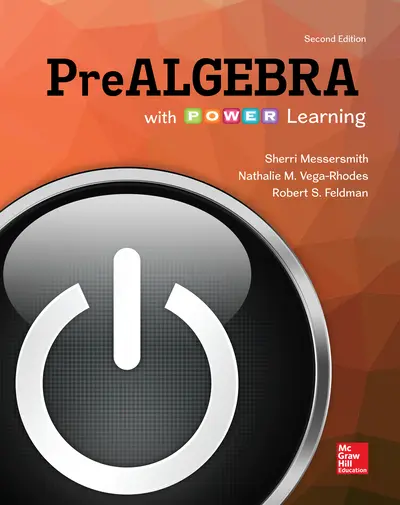Sherri Messersmith
Sherri Messersmith has been teaching at College of DuPage in Glen Ellyn, Illinois, since 1994. She has over 25 years of experience teaching many different courses from developmental mathematics through calculus. She earned a bachelor of science degree in the teaching of mathematics at the University of Illinois at Urbana-Champaign and went on to teach at the high level for two years. Sherri returned to UIUC and earned a master of science in applied mathematics and stayed on at the university to teach and coordinate large sections of undergraduate math courses. Sherri has authored several textbook, and she has also appeared in videos accompanying several McGraw-Hill texts.Sherri lives outside of Chicago with her husband, Phil, and their daughters, Alex and Cailen. In her precious free time, she likes to read, play the guitar, and travel -- the manuscripts for this and her previous books have accompanied her from Spain to Greece and many points in between.
Nathalie Vega-Rhodes
Nathalie Vega-Rhodes’ career in higher education began seventeen years ago and has encompassed a number of student-focused positions. For nearly a decade, she has taught mathematics ranging from developmental courses to calculus, as well as student success courses. She holds a Bachelor of Arts in Mathematics from the University of Houston and a Master of Science in Mathematics from the University of Houston—Clear Lake. In addition to teaching, as Mathematics Technology Coordinator at Lone Star College—Kingwood, she assists math faculty with technology-related pedagogical and implementation strategies. Her earliest work in higher education focused on academic support, first as a tutor and supplemental instruction (SI) leader, and then as a coordinator for a math tutoring and SI program. In her free time, Nathalie enjoys scuba diving and traveling with her husband, hanging out with her dog, and reading.
Robert Feldman
Bob Feldman still remembers those moments of being overwhelmed when he started college at Wesleyan University. “I wondered whether I was up to the challenges that faced me,” he recalls, “and—although I never would have admitted it at the time—I really had no idea what it took to be successful at college.”
That experience, along with his encounters with many students during his own teaching career, led to a life-long interest in helping students navigate the critical transition that they face at the start of their own college careers. Professor Feldman, who went on to receive a doctorate in psychology from the University of Wisconsin–Madison, is now Deputy Chancellor and Professor of Psychological and Brain Sciences at the University of Massachusetts Amherst. He is founding director of POWER Up for Student Success, the first-year experience course for incoming students.
Professor Feldman’s proudest professional accomplishment is winning the College Outstanding Teaching Award at UMass. He also has been named a Hewlett Teaching Fellow and was Senior Online Instruction Fellow. He has taught courses at Mount Holyoke College, Wesleyan University, and Virginia Commonwealth University. Professor Feldman is a Fellow of the American Psychological Association, the Association for Psychological Science, and the American Association for the Advancement of Science. He is a winner of a Fulbright Senior Research Scholar and Lecturer award and has written over 200 scientific articles, book chapters, and books. His books, some of which have been translated into Spanish, French, Portuguese, Dutch, Japanese, and Chinese, include Improving the First Year of College: Research and Practice; Understanding Psychology, 12/e; and Development Across the Life Span, 7/e. His research interests encompass the study of honesty and truthfulness in everyday life, development of nonverbal behavior in children, and the social psychology of education. His research has been supported by grants from the National Institute of Mental Health and the National Institute on Disabilities and Rehabilitation Research.
With the last of his three children completing college, Professor Feldman occupies his spare time with pretty decent cooking and earnest, but admittedly unpolished, piano playing. He also loves to travel. He lives with his wife, who is an educational psychologist, in a home overlooking the Holyoke mountain range in western Massachusetts.

